Petrological, Geochemical and Chronological Characteristics of Dolomites in the Permian Maokou Formation and Constraints to the Reservoir Genesis, Central Sichuan Basin, China
Abstract
:1. Introduction
2. Geological Setting
3. Petrology
4. Samples and Methods
5. Results
5.1. Degree of Dolomite Cation Ordering
5.2. Stable Carbon and Oxygen Isotopic Compositions
5.3. Stable Strontium Isotopic Composition
5.4. Rare Earth Elements
5.5. Element Mapping
5.6. U-Pb Dating
6. Discussion
6.1. Genesis of Dolomite
6.2. Reservoir Main Control Factors
7. Conclusions
Author Contributions
Funding
Data Availability Statement
Acknowledgments
Conflicts of Interest
References
- Ma, Y.S.; Guo, X.S.; Guo, T.L.; Huang, R.; Cai, X.; Li, G.X. The Puguang gas field: New giant discovery in the mature Sichuan Basin, southwest China. AAPG Bull. 2007, 91, 627–643. [Google Scholar] [CrossRef]
- Guo, X.S.; HU, D.F.; Li, Y.P.; Duan, J.B.; Ji, C.H.; Duan, H. Discovery and theoretical and technical innovations of Yuanba gas field in Sichuan Basin, SW China. Pet. Explor. Dev. 2018, 45, 14–26. [Google Scholar] [CrossRef]
- Du, J.H.; Zhou, C.N.; Xu, C.C.; He, H.Q.; Shen, P.; Yang, Y.M.; Li, Y.L.; Wei, G.Q.; Wang, Z.C.; Yang, Y. Theoretical and technical innovations in strategic discovery of a giant gas field in Cambrian Longwangmiao Formation of central Sichuan paleo-uplift, Sichuan Basin. Pet. Explor. Dev. 2014, 41, 268–277. [Google Scholar] [CrossRef]
- Yang, Y.M.; Yang, Y.; Wen, L.; Zhang, X.H.; Chen, C.; Chen, K.; Zhang, Y.; Di, G.L.; Wang, H.; Xie, C. New progress and prospect of Permian natural gas exploration in Sichuan Basin. Nat. Gas Ind. 2020, 40, 10–22. [Google Scholar] [CrossRef]
- Yang, Y.; Xie, J.R.; Zhao, L.Z.; Huang, P.H.; Zhang, X.H.; Chen, C.; Zhang, B.J.; Wen, L.; Wang, H.; Gao, Z.L.; et al. Breakthrough of natural gas exploration in the beach facies porous dolomite reservoir of Middle Permian Maokou Formation in the Sichuan Basin and its implications: A case study of the tridimensional exploration of Well JT1 in the central-northern Sichuan Basin. Nat. Gas Ind. 2021, 41, 1–9. [Google Scholar] [CrossRef]
- Liu, H.; Ma, T.; Tan, X.C.; Zeng, W.; Hu, G.; Xiao, D.; Luo, B.; Shan, S.J.; Su, C.P. Origin of structurally controlled hydrothermal dolomite in epigenetic karst system during shallow burial: An example from Middle Permian Maokou Formation, central Sichuan Basin, SW China. Pet. Explor. Dev. 2016, 43, 916–927. [Google Scholar] [CrossRef]
- Jiang, Y.Q.; Gu, Y.F.; Li, K.H.; Li, S.; Luo, M.S.; He, B. Spatial types and genesis of Middle Permian hydrothermal dolomite reservoirs in central Sichuan Basin. Nat. Gas Ind. 2018, 38, 16–24. [Google Scholar] [CrossRef]
- Liu, J.Q.; Zheng, H.F.; Liu, B.; Liu, H.G.; Shi, K.B.; Guo, R.T.; Zhang, X.F. Characteristics and genetic mechanism of the dolomite in the Middle Permian Maokou Formation, central Sichuan area. Acta Pet. Sin. 2017, 38, 386–398. [Google Scholar] [CrossRef]
- Hu, A.P.; Pan, L.Y.; Hao, Y.; Shen, A.J.; Gu, M.F. Origin, Characteristics and Distribution of Dolostone Reservoir in Qixia Formation and Maokou Formation, Sichuan Basin, China. Marin. Orig. Petrl. Geol. 2018, 23, 39–52. [Google Scholar] [CrossRef]
- Hu, D.F.; Wang, L.J.; Huang, R.C.; Duan, J.B.; Xu, Z.X.; Pan, L. Characteristics of dolomite reservoirs in the middle Permian Maokou Formation in the eastern Sichuan Basin and their main controlling factors. Nat. Gas Ind. 2019, 39, 13–21. [Google Scholar] [CrossRef]
- Li, R.B.; Duan, J.B.; Pan, L.; Li, H. Genetic mechanism and main controlling factors of the Middle Permian Maokou Formation dolomite reservoirs in the eastern Sichuan Basin. Nat. Gas Geosci. 2021, 32, 1347–1357. [Google Scholar] [CrossRef]
- Zhao, W.Z.; Shen, A.J.; Hu, S.Y.; Zhang, B.M.; Pan, W.Q.; Zhou, J.G.; Wang, Z.C. Geological conditions and distributional features of large-scale carbonate reservoirs onshore China. Pet. Explor. Dev. 2012, 39, 1–12. [Google Scholar] [CrossRef]
- Liu, S.G.; Yang, Y.; Deng, B.; Zhong, Y.; Wen, L.; Sun, W.; Li, Z.W.; Jansa, L.; Li, J.X.; Song, J.M.; et al. Tectonic evolution of the Sichuan Basin, Southwest China. Earth-Sci. Rev. 2021, 213, 103470. [Google Scholar] [CrossRef]
- Ma, B.S.; Liang, H.; Wu, G.H.; Tang, Q.S.; Tian, W.Z.; Zhang, C.; Yang, S.; Zhong, Y.; Zhang, X.; Zhang, Z.L. Formation and evolution of the strike-slip faults in the central Sichuan Basin, SW China. Pet. Explor. Dev. 2023, 50, 333–345. [Google Scholar] [CrossRef]
- Gu, M.F.; Liu, R.; Zhang, H.; He, Y.; Li, K.Y.; Hao, Y.; Jiang, H.; Li, W.Z. Characteristics of Caledonian tectonic movement and its geological response in Sichuan Basin. Nat. Gas Ind. 2023, 43, 32–43. [Google Scholar]
- Zhong, Y.; Yang, Y.M.; Wen, L.; Luo, B.; Xiao, D.; Tan, X.C.; Zhao, L.K.; Li, M.L. Sedimentary environments controlled by tectonics and induced differential subsidence: A perspective in the Permian Liangshan and Qixia Formations, northwestern Sichuan Basin, China. J. Cent. South Univ. 2020, 27, 3398–3416. [Google Scholar] [CrossRef]
- Huang, S.P.; Jiang, Q.C.; Jiang, H.; Tang, Q.S.; Zeng, F.Y.; Lu, W.H.; Hao, C.G.; Yuan, M.; Wu, Y. Genetic and source differences of gases in the Middle Permian Qixia and Maokou formations in the Sichuan Basin, SW China. Org. Geochem. 2023, 178, 104574. [Google Scholar] [CrossRef]
- Zhao, Z.J.; Zhou, H.; Chen, X.; Liu, Y.H.; Zhang, Y.B.; Liu, Y.E.; Yang, Y. Sequence lithofacies paleogeography and favorable exploration zones of the Permian in Sichuan Basin and adjacent areas, China. Acta Pet. Sin. 2012, 33, 35–51. [Google Scholar] [CrossRef]
- Li, D.J.; Chen, H.; Chen, H.D.; Liang, H.; Peng, C.; Xia, M.; Duan, H.Z. Relationship between reservoir development in the Middle Permian Maokou Formation and paleostructure evolution in the Sichuan Basin. Oil Gas Geol. 2016, 37, 756–763. [Google Scholar] [CrossRef]
- Hu, M.Y.; Hu, Z.G.; Wei, G.Q.; Yang, W.; Liu, M.C. Sequence lithofacies paleogeography and reservoir potential of the Maokou Formation in Sichuan Basin. Pet. Explor. Dev. 2012, 39, 45–55. [Google Scholar] [CrossRef]
- Tian, X.B.; Shi, J.B.; Dong, J.H.; Tan, W.C.; Yin, C.H.; Li, Q.; Song, Z.Y.; Zhang, K.; Xiao, C.T. New understanding of sedimentary facies of the first member of Maokou Formation based on the latest drilling in central Sichuan Basin. Nat. Gas Geosci. 2021, 32, 1646–1655. [Google Scholar]
- Goldsmith, J.R.; Graf, D.L. Structural and compositional variations in some natural dolomites. J. Geol. 1958, 66, 678–693. [Google Scholar] [CrossRef]
- Helie, J.F.; Adamowicz-Walczak, A.; Middlestead, P.; Chartrand, M.M.G.; Mester, Z.; Meija, J. Discontinuity in the Realization of the Vienna Peedee Belemnite Carbon Isotope Ratio Scale. Anal. Chem. 2021, 93, 10740–10743. [Google Scholar] [CrossRef]
- Shen, A.J.; Zhao, W.Z.; Hu, A.P.; Wang, H.; Liang, F.; Wang, Y.S. The datingand temperature measurement technologies for carbonate minerals and their application in hydrocarbon accumulation research in the paleo-uplift in central Sichuan Basin, SW China. Pet. Explor. Dev. 2021, 48, 476–487. [Google Scholar] [CrossRef]
- Merlini, M.; Sapelli, F. High-temperature and high-pressure behavior of carbonates in the ternary diagram CaCO3-MgCO3-FeCO3. Am. Mineral. 2006, 101, 1423–1430. [Google Scholar] [CrossRef]
- Deng, M.; Qian, G.R.; Tang, M.S. Ordered index and dedolomitization of dolomite crystals. J. Nanjing Univ. Chem. Technol. 2001, 23, 1–5. [Google Scholar] [CrossRef]
- Zheng, J.F.; Wang, H.; Shen, A.J.; Luo, X.Y.; Zhao, C.; Dai, K. Genesis of Dolomite Reservoir in Ediacaran Chigbrak Formation of Tarim Basin, NW China: Evidence from U–Pb Dating, Isotope and Element Geochemistry. Am. Mineral. 2023, 13, 725. [Google Scholar] [CrossRef]
- Northrop, D.A.; Clayton, R.N. Oxygen-isotope fractionations in systems containing dolomite. J. Geol. 1966, 74, 174–196. [Google Scholar] [CrossRef]
- Saller, A.H.; Dickson, J.A.D. Partial dolomitization of a Pennsylvanian limestone buildup by hydrothermal fluids and its effect on reservoir quality and performance. AAPG Bull. 2011, 95, 1745–1762. [Google Scholar] [CrossRef]
- Veizer, J.; Ala, D.; Azmy, K.; Bruckschen, P.; Buhl, D.; Bruhn, F.; Carden, G.A.; Diener, A.; Ebneth, S.; Godderis, Y. 87Sr/86Sr, δ13C and δ18O evolution of Phanerozoic seawater. Chem. Geol. 1999, 161, 59–88. [Google Scholar] [CrossRef]
- Baud, A.; Magaritz, M.; Holser, W.T. Permian-Triassic of the Tethys: Carbon isotope studies. Geol. Rundsch. 1989, 78, 649–677. [Google Scholar] [CrossRef]
- Burns, S.J.; Haudenschild, U.; Matter, A. The strontium isotopic composition of carbonates from the late Precambrian (∼560–540 Ma) Huqf Group of Oman. Chem. Geol. 1994, 111, 269–282. [Google Scholar] [CrossRef]
- Lottermoser, B.G. Rare earth elements and hydrothermal ore formation processes. Ore Geol. Rev. 1992, 7, 25–41. [Google Scholar] [CrossRef]
- Zheng, J.F.; Shen, A.J.; Qiao, Z.F.; Wu, X.N.; Zhang, T.F. Characteristics and pore genesis of dolomite in the Penglaiba Formation in Keping-Bachu outcrop area. Acta Pet. Sin. 2014, 35, 664–672. [Google Scholar] [CrossRef]
- McLennan, S.M.; Taylor, S.; McGregor, V. Geochemistry of Archean metasedimentary rocks from West Greenland. Geochim. Cosmochim. Acta 1984, 48, 1–13. [Google Scholar] [CrossRef]
- Drost, K.; Chew, D.; Petrus, J.A.; Scholze, F.; Woodhead, J.D.; Schneider, J.W.; Harper, D.A.T. An Image Mapping Approach to U-Pb LA-ICP-MS Carbonate Dating and Applications to Direct Dating of Carbonate Sedimentation. Geochem. Geophys. Geosyst. 2018, 19, 4631–4648. [Google Scholar] [CrossRef]
- Zheng, J.; Zhu, Y.J.; Huang, L.L.; Guo, Y.; Hu, F.J. Geochemical Characteristics and Their Geological Significance of Lower Cambrian Xiaoerblak Formation in Northwestern Tarim Basin, China. Am. Minerals. 2022, 12, 781. [Google Scholar] [CrossRef]
- Shen, A.J.; Luo, X.Y.; Hu, A.P.; Qiao, Z.F.; Zhang, J. Dolomitization evolution and its effects on hydrocarbon reservoir formation from penecontemporaneous to deep burial environment. Pet. Explor. Dev. 2022, 49, 637–647. [Google Scholar] [CrossRef]
- Korte, C.; Jasper, T.; Kozur, H.W.; Veizer, J. δ18O and δ13C of Permian brachiopods: A record of seawater evolution and continental glaciation. Palaeogeogr. Palaeoclimatol. Palaeoecol. 2005, 224, 333–351. [Google Scholar] [CrossRef]
- Zheng, J.F.; Huang, L.L.; Yuan, W.F.; Zhu, Y.J.; Qiao, Z.F. Geochemical features and its significance of sedimentary and diagenetic environment in the Lower Cambrian Xiaoerblak Formation of Keping area, Tarim Basin. Nat. Gas Geosci. 2020, 31, 698–709. [Google Scholar] [CrossRef]
- Zheng, J.F.; Shen, A.J.; Liu, Y.F.; Chen, Y.Q. Multi-parameter comprehensive identification of the genesis of Lower Paleozoic dolomite in Tarim Basin, China. Acta Pet. Sin. 2012, 33, 145–153. [Google Scholar] [CrossRef]
- Grimes, K. Syngenetic Karst in Australia: A Review. Helictite 2003, 39, 27–38. [Google Scholar]
- Fu, X.D.; Zhang, B.J.; Wang, Z.C.; Lei, M.; Zhang, J.Y.; Guang, S.W.; Li, W.Z.; Zhong, Y.; Gu, M.F.; Chen, T. Strike-Slip Faults in Central and Western Sichuan Basin and Their Control Functions on Hydrocarbon Accumulation. Earth Sci. 2023, 48, 2221–2237. [Google Scholar]
- Sun, Z.M.; Bian, C.R.; Liu, G.X. Advances on Emeishan Mantle Plume and Discussions on Dynamic Mechanism of Formation of Sichuan Basin in Permian. Geosciences 2023, 1–15. [Google Scholar] [CrossRef]
- Liang, X.Y.; Li, H.; Zhang, D.D.; Yang, K.; Zhou, D.W.; Zheng, T.Y.; Dong, Y.K.; Zhai, L.G. Geochemical characteristics and genetic analysis of Huayingshan Emeishan basalt in Sichuan Basin. Sci. Geol. Sin. 2022, 56, 288–302. [Google Scholar] [CrossRef]
- Zhu, C.Q.; Xu, M.; Yuan, Y.S.; Zhao, Y.Q.; Shan, J.N.; He, Z.G.; Tian, Y.T.; Hu, S.B. Palaeo-geothermal response and record of the effusing of Emeishan basalts in Sichuan basin. Chin. Sci. Bull. 2010, 55, 474–482. [Google Scholar] [CrossRef]
- Li, H.B.; Zhang, Z.C.; Lv, L.S.; Wang, Y.F.; Kou, C.H.; Li, Y.S.; Liao, B.L. Isopach maps of the Qixia and Maokou formations: Implication for mantle plume model of the Emeishan large igneous province. Acta Pet. Sin. 2011, 27, 2963–2974. [Google Scholar]
- He, W.Y.; Meng, Q.A.; Yin, C.H.; Wang, X.D.; Zhang, H.J.; Shi, J.B. Geological characteristics and favorable exploration plays of gas in Qixia Formation dolomite in Hechuan-Tongnan area of Sichuan Basin. Petroleum Pet. Geol. Oilfield Dev. Daqing. 2022, 41, 1–11. [Google Scholar] [CrossRef]
- Clyde, H.M. Carbonate reservoirs-porosity evolution and diagenesis in a sequence stratigraphic framework. Mar. Pet. Geol. 2001, 19, 293–298. [Google Scholar] [CrossRef]



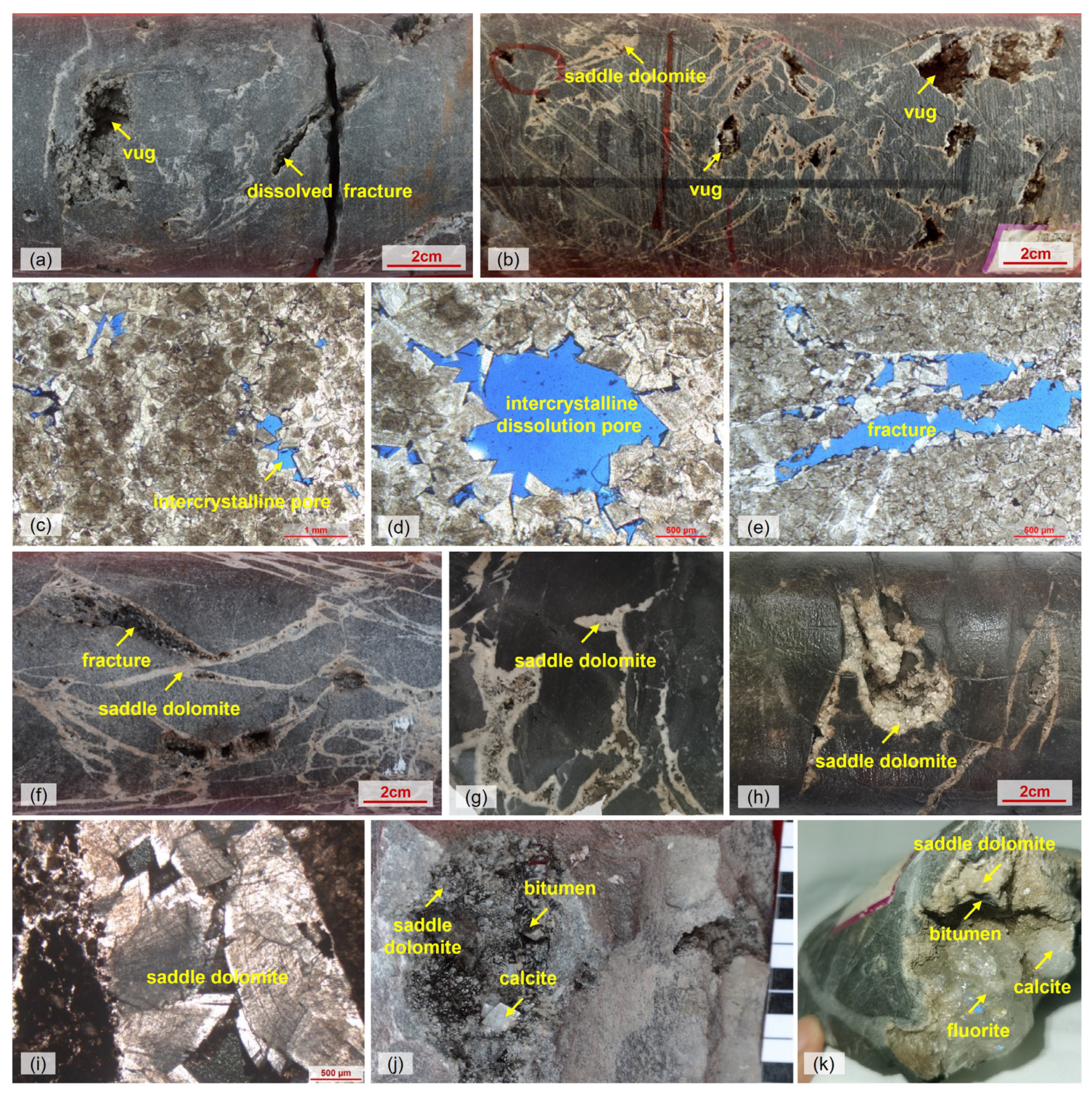
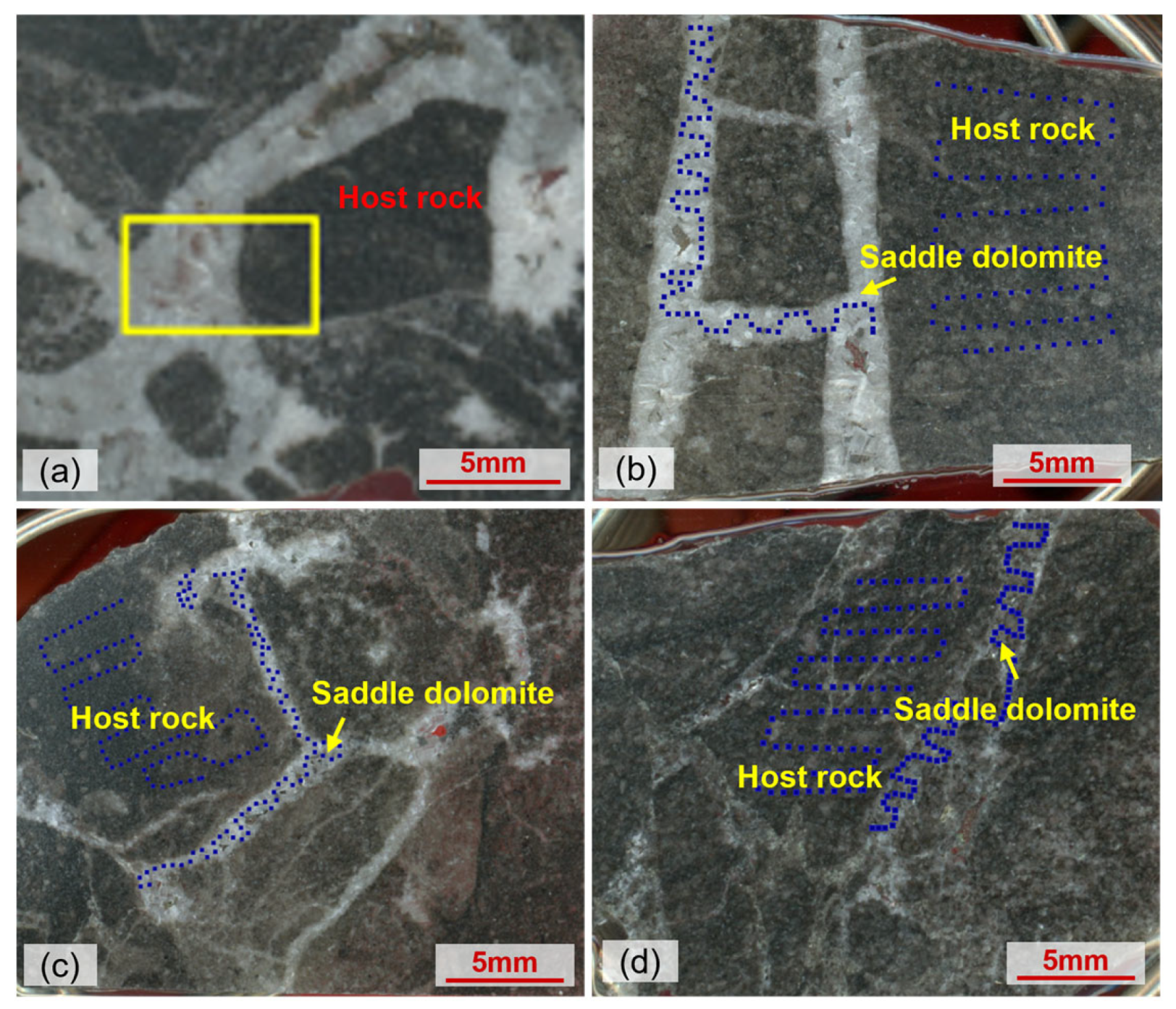


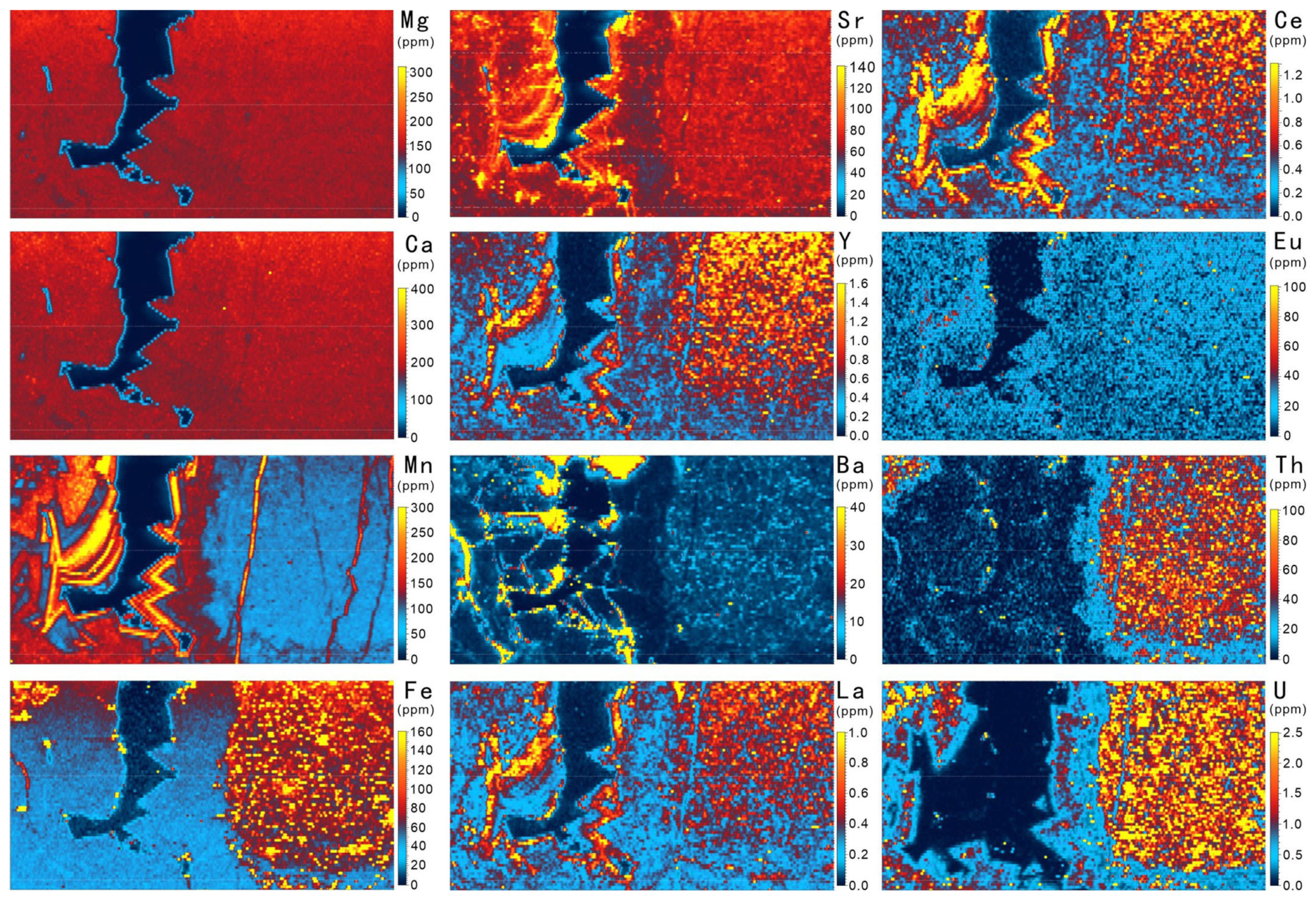
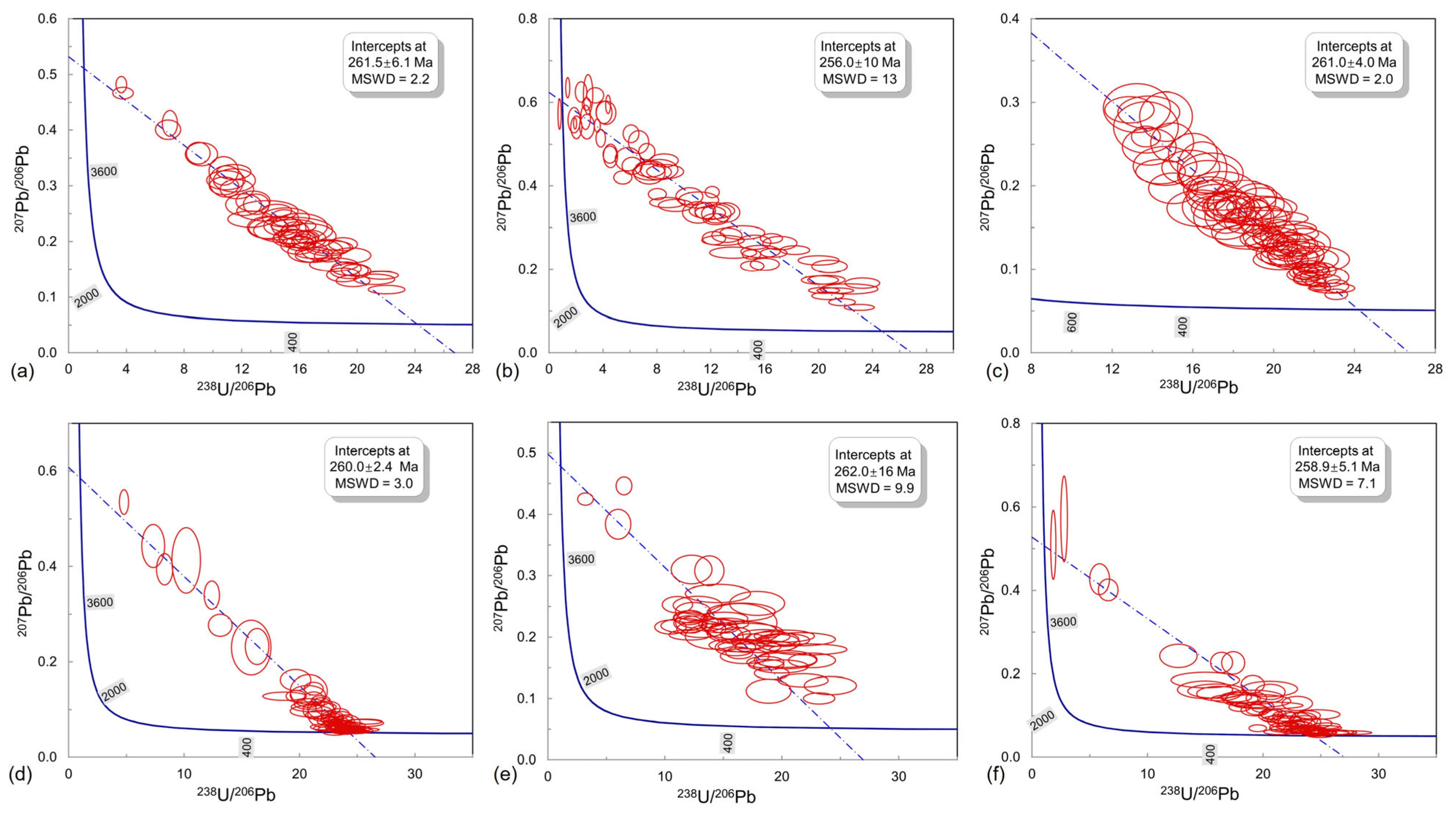
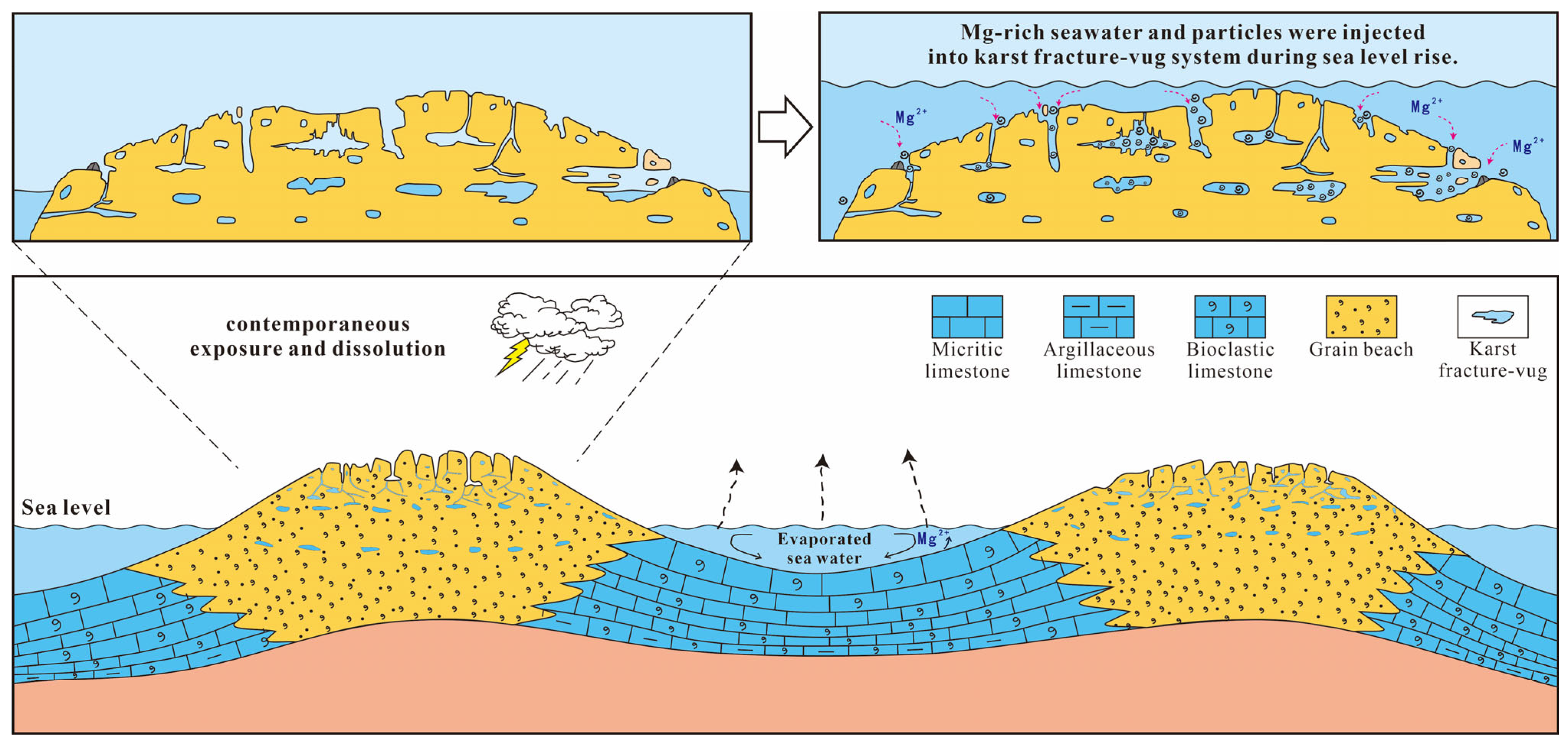
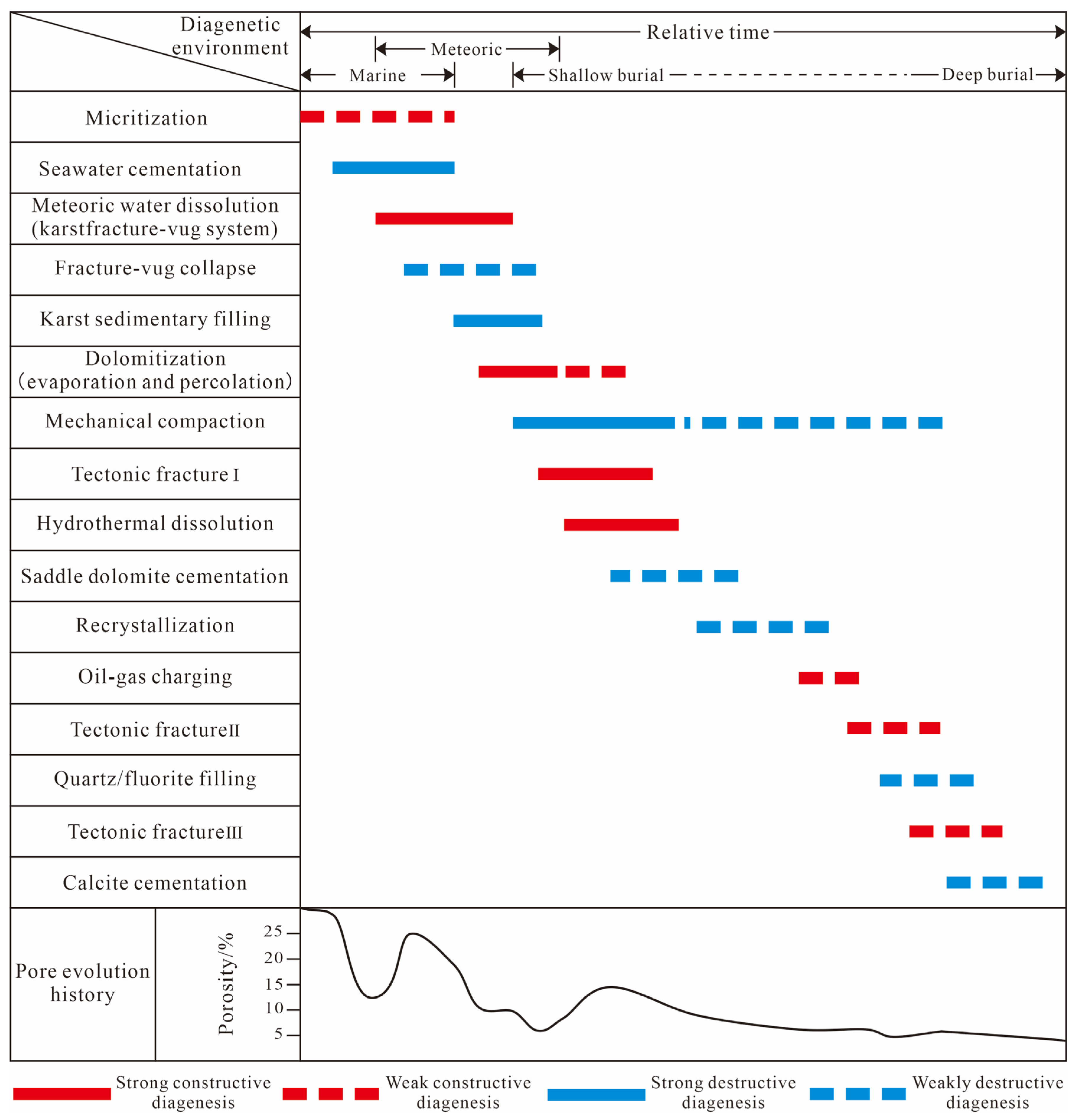
| Lithology | Member | Sample | Depth/m | Lithology | Member | Sample | Depth/m |
|---|---|---|---|---|---|---|---|
| Limestone | Mao-2 | TS4-1 | 4253.3 | Dolomite | Mao-2 | TS4-15 | 4270 |
| Limestone | Mao-2 | TS4-2 | 4255.4 | Dolomite | Mao-2 | TS4-16 | 4270.9 |
| Dolomite | Mao-2 | TS4-3 | 4257.2 | Dolomite | Mao-2 | TS4-17 | 4271.9 |
| Dolomite | Mao-2 | TS4-4 | 4258.4 | Dolomite | Mao-2 | TS4-18 | 4273 |
| Dolomite | Mao-2 | TS4-5 | 4259.7 | Dolomite | Mao-2 | TS4-19 | 4274.7 |
| Dolomite | Mao-2 | TS4-6 | 4260.9 | Limestone | Mao-2 | TS4-20 | 4276.2 |
| Dolomite | Mao-2 | TS4-7 | 4262.1 | Limestone | Mao-2 | TS4-21 | 4278.4 |
| Dolomite | Mao-2 | TS4-8 | 4263.1 | Limestone | Mao-2 | TS4-22 | 4279.8 |
| Dolomite | Mao-2 | TS4-9 | 4264.2 | Limestone | Mao-2 | TS4-23 | 4281.4 |
| Dolomite | Mao-2 | TS4-10 | 4265.2 | Limestone | Mao-2 | TS4-24 | 4282.8 |
| Dolomite | Mao-2 | TS4-11 | 4266.2 | Limestone | Mao-2 | TS4-25 | 4284.3 |
| Dolomite | Mao-2 | TS4-12 | 4267.2 | Limestone | Mao-2 | TS4-26 | 4286.4 |
| Dolomite | Mao-2 | TS4-13 | 4268.1 | Limestone | Mao-2 | TS4-27 | 4288.7 |
| Dolomite | Mao-2 | TS4-14 | 4269.1 | Limestone | Mao-2 | TS4-28 | 4291.2 |
| Sample | Lithology | Order Degree | δ13C ‰ (PDB) | δ18O ‰ (PDB) | 87Sr/86Sr |
|---|---|---|---|---|---|
| TS4-1 | Limestone | / | 4.54 | −7.03 | 0.707266 |
| TS4-2 | Limestone | / | 4.30 | −7.31 | / |
| TS4-21 | Limestone | / | 4.28 | −7.45 | 0.707317 |
| TS4-22 | Limestone | / | 4.14 | −6.82 | / |
| TS4-23 | Limestone | / | 4.61 | −7.27 | 0.707223 |
| TS4-24 | Limestone | / | 4.01 | −6.94 | / |
| TS4-25 | Limestone | / | 4.46 | −7.59 | 0.707215 |
| TS4-26 | Limestone | / | 4.65 | −6.94 | 0.707330 |
| TS4-27 | Limestone | / | 4.17 | −7.64 | / |
| TS4-28 | Limestone | / | 4.25 | −6.95 | 0.707245 |
| TS4-3 | Dolomite | 0.58 | 3.93 | −7.62 | 0.707278 |
| TS4-4 | Dolomite | 0.55 | 3.98 | −6.74 | 0.707341 |
| TS4-5 | Dolomite | 0.54 | 3.77 | −7.19 | 0.707452 |
| TS4-6 | Dolomite | 0.69 | 4.09 | −7.33 | / |
| TS4-7 | Dolomite | 0.71 | 3.90 | −7.57 | 0.707380 |
| TS4-8 | Dolomite | 0.59 | 3.93 | −6.94 | 0.707415 |
| TS4-9 | Dolomite | / | 3.82 | −7.48 | / |
| TS4-10 | Dolomite | 0.60 | 3.80 | −7.25 | 0.707324 |
| TS4-11 | Dolomite | / | 4.03 | −6.79 | / |
| TS4-12 | Dolomite | 0.59 | 3.63 | −6.71 | 0.707458 |
| TS4-13 | Dolomite | / | 4.07 | −6.84 | / |
| TS4-14 | Dolomite | 0.55 | 3.93 | −6.73 | 0.707497 |
| TS4-15 | Dolomite | 0.63 | 3.78 | −7.00 | 0.707593 |
| TS4-16 | Dolomite | 0.51 | 3.95 | −7.46 | 0.707676 |
| TS4-17 | Dolomite | / | 3.71 | −7.03 | 0.707639 |
| TS4-18 | Dolomite | 0.56 | 3.76 | −7.41 | / |
| TS4-19 | Dolomite | 0.60 | 3.52 | −7.55 | 0.707587 |
| TS4-20 | Dolomite | 0.60 | 4.03 | −7.07 | 0.707533 |
| Sample | Lithology | La (ppm) | Ce (ppm) | Pr (ppm) | Nd (ppm) | Sm (ppm) | Eu (ppm) | Gd (ppm) | Tb (ppm) | Dy (ppm) | Ho (ppm) | Er (ppm) | Tm (ppm) | Yb (ppm) | Lu (ppm) | ΣREEs (ppm) |
|---|---|---|---|---|---|---|---|---|---|---|---|---|---|---|---|---|
| TS4-1 | Limestone | 0.277 | 0.494 | 0.059 | 0.227 | 0.042 | 0.009 | 0.045 | 0.007 | 0.045 | 0.011 | 0.034 | 0.005 | 0.034 | 0.005 | 1.294 |
| TS4-22 | Limestone | 0.195 | 0.358 | 0.041 | 0.158 | 0.031 | 0.006 | 0.031 | 0.005 | 0.032 | 0.007 | 0.024 | 0.004 | 0.022 | 0.003 | 0.917 |
| TS4-25 | Limestone | 0.375 | 0.692 | 0.083 | 0.32 | 0.066 | 0.013 | 0.068 | 0.011 | 0.068 | 0.016 | 0.049 | 0.008 | 0.046 | 0.007 | 1.822 |
| TS4-27 | Limestone | 0.324 | 0.526 | 0.066 | 0.257 | 0.052 | 0.01 | 0.056 | 0.009 | 0.058 | 0.014 | 0.043 | 0.006 | 0.035 | 0.006 | 1.462 |
| TS4-4 | Dolomite | 0.489 | 0.903 | 0.107 | 0.395 | 0.076 | 0.014 | 0.074 | 0.012 | 0.08 | 0.018 | 0.055 | 0.008 | 0.053 | 0.009 | 2.293 |
| TS4-6 | Dolomite | 0.346 | 0.633 | 0.077 | 0.285 | 0.06 | 0.011 | 0.065 | 0.01 | 0.066 | 0.015 | 0.048 | 0.007 | 0.044 | 0.007 | 1.674 |
| TS4-7 | Dolomite | 0.554 | 1.030 | 0.123 | 0.461 | 0.089 | 0.016 | 0.089 | 0.014 | 0.086 | 0.021 | 0.065 | 0.011 | 0.067 | 0.01 | 2.636 |
| TS4-8 | Dolomite | 0.828 | 1.570 | 0.177 | 0.651 | 0.128 | 0.025 | 0.122 | 0.02 | 0.128 | 0.030 | 0.084 | 0.013 | 0.079 | 0.013 | 3.868 |
| TS4-9 | Dolomite | 0.705 | 1.390 | 0.166 | 0.638 | 0.138 | 0.026 | 0.135 | 0.022 | 0.138 | 0.032 | 0.097 | 0.016 | 0.095 | 0.015 | 3.613 |
| TS4-10 | Dolomite | 0.751 | 1.413 | 0.166 | 0.617 | 0.12 | 0.021 | 0.115 | 0.018 | 0.117 | 0.027 | 0.083 | 0.013 | 0.082 | 0.013 | 3.556 |
| TS4-11 | Dolomite | 0.871 | 1.640 | 0.198 | 0.739 | 0.142 | 0.024 | 0.134 | 0.021 | 0.138 | 0.031 | 0.1 | 0.016 | 0.098 | 0.016 | 4.168 |
| TS4-12 | Dolomite | 0.651 | 1.178 | 0.140 | 0.521 | 0.101 | 0.019 | 0.098 | 0.016 | 0.100 | 0.023 | 0.071 | 0.011 | 0.068 | 0.011 | 3.008 |
| TS4-14 | Dolomite | 0.270 | 0.471 | 0.060 | 0.234 | 0.046 | 0.012 | 0.048 | 0.008 | 0.049 | 0.012 | 0.034 | 0.005 | 0.030 | 0.005 | 1.284 |
| Sample | Components | U-Pb Age (Ma) | Components | U-Pb Age (Ma) |
|---|---|---|---|---|
| TS4-6 | Host rock (dolomite) | 261 ± 6.1 | Saddle dolomite | 256.0 ± 10 |
| TS4-10 | Host rock (dolomite) | 261.0 ± 4.0 | Saddle dolomite | 258.9 ± 5.1 |
| TS4-15 | Host rock (dolomite) | 262.0 ± 16 | Saddle dolomite | 260.0 ± 2.4 |
Disclaimer/Publisher’s Note: The statements, opinions and data contained in all publications are solely those of the individual author(s) and contributor(s) and not of MDPI and/or the editor(s). MDPI and/or the editor(s) disclaim responsibility for any injury to people or property resulting from any ideas, methods, instructions or products referred to in the content. |
© 2023 by the authors. Licensee MDPI, Basel, Switzerland. This article is an open access article distributed under the terms and conditions of the Creative Commons Attribution (CC BY) license (https://creativecommons.org/licenses/by/4.0/).
Share and Cite
Bai, X.; Zheng, J.; Dai, K.; Hong, S.; Duan, J.; Liu, Y. Petrological, Geochemical and Chronological Characteristics of Dolomites in the Permian Maokou Formation and Constraints to the Reservoir Genesis, Central Sichuan Basin, China. Minerals 2023, 13, 1336. https://doi.org/10.3390/min13101336
Bai X, Zheng J, Dai K, Hong S, Duan J, Liu Y. Petrological, Geochemical and Chronological Characteristics of Dolomites in the Permian Maokou Formation and Constraints to the Reservoir Genesis, Central Sichuan Basin, China. Minerals. 2023; 13(10):1336. https://doi.org/10.3390/min13101336
Chicago/Turabian StyleBai, Xuejing, Jianfeng Zheng, Kun Dai, Shuxin Hong, Junmao Duan, and Yunmiao Liu. 2023. "Petrological, Geochemical and Chronological Characteristics of Dolomites in the Permian Maokou Formation and Constraints to the Reservoir Genesis, Central Sichuan Basin, China" Minerals 13, no. 10: 1336. https://doi.org/10.3390/min13101336






